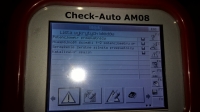Hello everyone
The problem concerns the megi I with the 1.6 16V engine without gas.
The car after the "porazówce" goes down with revolutions at about 600 revolutions, then after 3-4 seconds it returns to 750 and stays like that regardless of the air conditioning or the brake pressed, etc. The car did not go out by itself, nor has any error.
What I did:
- cleaning the throttle and the potentiometer guide
- cleaning and clogging of all electrical connections of the contact spray
- the inlet seal (when the air filter is blocked by hand, it goes out)
According to computer, gas potentiometers work well from 14% up (checked on two identical cars).
The throttle at idle has 0.94% opening and goes to 10% (same as on the second car)
Throttle potentiometers start:
one from 80% and the other from 22% and they change, one decreasing and the other increasing, but there is always 1-2% "surplus" - there is this relationship for both cars.
The only difference between these cars is the readings of the second lambda probe. In this, the second probe remains around 0 mV without any problems, and in this one it jumps with a fault and is quite similar to the first probe. Both cars were equally hot, even standing in the same place.
Could this difference cause the revolutions to drop below idle?
The problem concerns the megi I with the 1.6 16V engine without gas.
The car after the "porazówce" goes down with revolutions at about 600 revolutions, then after 3-4 seconds it returns to 750 and stays like that regardless of the air conditioning or the brake pressed, etc. The car did not go out by itself, nor has any error.
What I did:
- cleaning the throttle and the potentiometer guide
- cleaning and clogging of all electrical connections of the contact spray
- the inlet seal (when the air filter is blocked by hand, it goes out)
According to computer, gas potentiometers work well from 14% up (checked on two identical cars).
The throttle at idle has 0.94% opening and goes to 10% (same as on the second car)
Throttle potentiometers start:
one from 80% and the other from 22% and they change, one decreasing and the other increasing, but there is always 1-2% "surplus" - there is this relationship for both cars.
The only difference between these cars is the readings of the second lambda probe. In this, the second probe remains around 0 mV without any problems, and in this one it jumps with a fault and is quite similar to the first probe. Both cars were equally hot, even standing in the same place.
Could this difference cause the revolutions to drop below idle?



